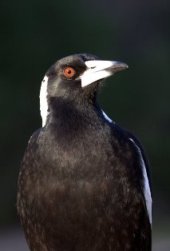About magpies

Our backyard lawns, parks, school grounds and paddocks may have been designed for people but they have also created habitat for birds, such as the Australian magpie Cracticus tibicen, that like to live in grassy, lightly treed areas.
Magpies occur over much of Australia, often live in small groups of up to five individuals (in Queensland), and take up territories that include nesting and roosting trees and grassy feeding areas.
Living so closely to people has helped make the magpie an icon of the Australian bush and backyard. The bold black and white markings of a magpie and its wavering flute-like song are among the most recognisable elements of the Australian landscape.
To a magpie, a territory is the foundation of their survival. Without it, they will not breed and will also face the constant risk of attack when they trespass on to the territories of other magpies.
The territorial swooper
For most of the year people and magpies happily co-exist, sharing open space and backyards. For a few weeks of the year, the safety of a magpie’s young becomes its primary concern, and they may no longer be willing to share the area surrounding their nest and chicks.
Only a small proportion of magpies swoop on people and these often have a preference for a few individuals that the birds recognise, or certain types of ‘targets’ like pedestrians and cyclists.
By understanding magpies and knowing how to behave around them, you can stay safe from a swooping magpie.
Listening for lunch
Magpies have an amazing ability to listen for the sounds of moving prey just below the surface of the soil—an ability that doesn’t seem to be shared by other ground-feeding birds like crows. Once located, the magpie’s long, sharp beak pinches out its prey and eats it.
Experiments have found that a magpie can find buried lawn grubs 96 times out of 100, making them one of the best backyard lawn grub eradicators.

An Australian symbol
Magpies are tough birds, protective of their patch and their young. These qualities have helped magpies become a symbol for many Australians—as emblems for sporting teams and social clubs, and even as a nickname for someone with a keen eye for finding things.
But the magpie is also a reminder that nature is something we live beside rather than control. By understanding magpies, we can live alongside this singing companion that keeps our lawns free from lawn grubs, and safely manage the small risk of a swoop from a protective parent raising its young.
Source of information
Jones DN 2002, Magpie alert: learning to live with a wild neighbour, University of New South Wales Press, Sydney.


